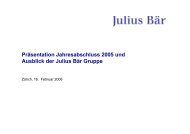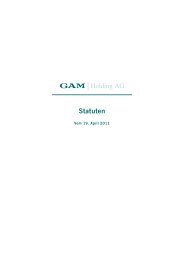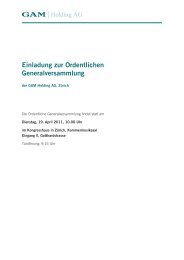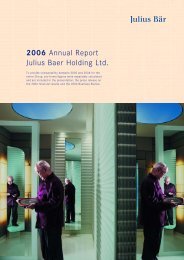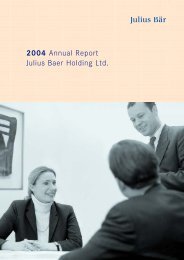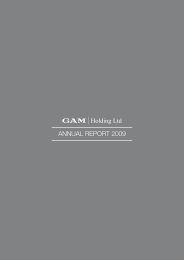2005 Annual Report Julius Baer Holding Ltd. - GAM Holding AG
2005 Annual Report Julius Baer Holding Ltd. - GAM Holding AG
2005 Annual Report Julius Baer Holding Ltd. - GAM Holding AG
You also want an ePaper? Increase the reach of your titles
YUMPU automatically turns print PDFs into web optimized ePapers that Google loves.
Intangible assets<br />
Intangible assets are classified into the categories of<br />
goodwill, customer relationships, brand and other.<br />
Customer relationships comprise long-term customer<br />
relationship intangibles from the acquisition of the<br />
three private banks and <strong>GAM</strong> and are amortized<br />
using the straight-line method over their estimated<br />
useful life of ten years. The <strong>Julius</strong> <strong>Baer</strong> Group expects<br />
there to be no foreseeable end to the useful life of<br />
the intangible assets in the brand category. These<br />
intangible assets have an indefinite useful life and are<br />
therefore not written off.<br />
The assets and liabilities of acquired subsidiaries are<br />
revalued for the capital consolidation at the time of<br />
acquisition. The resulting fair value of the identifiable<br />
net assets is set off against the purchase price paid,<br />
and any resulting difference is recognized in the balance<br />
sheet as goodwill. If, based on the annual<br />
impairment test at the cash-generating-unit level,<br />
goodwill no longer merits capitalization, a write-off is<br />
made at that time. Until the end of the 2004 financial<br />
year, goodwill was amortized using the straight-line<br />
method over its estimated useful life, but not exceeding<br />
20 years.<br />
Software that is purchased is capitalized and written<br />
off over its useful life. Minor purchases are debited<br />
directly to general expenses.<br />
Similarly to purchased software, internally generated<br />
software is also capitalized insofar as the conditions<br />
of IAS 38 are fulfilled, i.e. it is probable that the<br />
future economic benefits that are attributable to the<br />
asset will flow to the company and that the costs of<br />
the asset can be identified and measured reliably.<br />
The capitalized assets are written off using the<br />
straight-line method over their useful life. The depreciation<br />
period usually lasts for three to five years.<br />
On each balance sheet date, the intangible assets are<br />
reviewed for indications of impairment, changes in<br />
estimated future benefits or reasons for altering<br />
Notes<br />
depreciation method. If such indications exist, it is<br />
determined whether the carrying amount of the intangible<br />
assets is fully recoverable. A write-down is<br />
made if the carrying amount exceeds the recoverable<br />
amount. Changes in useful life or in depreciation<br />
method are recognized in the income statement.<br />
Intangible assets with an indefinite useful life are<br />
capitalized in the balance sheet and tested annually<br />
for impairment and to confirm their indefinite status.<br />
Liabilities<br />
Liabilities are reported at fair value. Interest and discounts<br />
are debited to interest expenses on an accrual<br />
basis.<br />
Debt issued<br />
Issued bonds and mortgage-backed bonds are initially<br />
recorded at cost, i.e. at the fair value of the remuneration<br />
received minus the transaction expenses. They<br />
are subsequently stated in the balance sheet at amortized<br />
cost using the effective interest rate method.<br />
Provisions<br />
A provision is recognized if, as a result of a past<br />
event, a current liability exists on the balance sheet<br />
date that will probably lead to an outflow of<br />
resources and whose amount can be reliably estimated.<br />
If an outflow of resources is not likely or the<br />
amount of the liability cannot be reliably estimated, a<br />
contingent liability is recognized. If, as a result of a<br />
past event, there is a possible liability on the balance<br />
sheet date whose existence depends on future developments<br />
that are not fully under the control of <strong>Julius</strong><br />
<strong>Baer</strong> <strong>Holding</strong> <strong>Ltd</strong>., a contingent liability is likewise<br />
recognized. The recognition and release of provisions<br />
are recorded in the income statement through the<br />
item valuation adjustments, provisions and losses.<br />
Restructuring provisions in the event of sale or termination<br />
of a line of business, closure or relocation of<br />
business locations, changes in management structure<br />
or fundamental reorganization are recognized if,<br />
in addition to the general accounting policies, the<br />
JULIUS BAER GROUP 75





